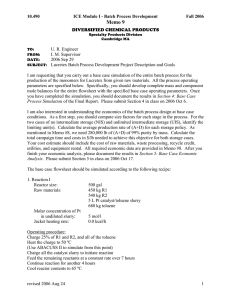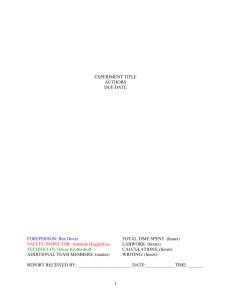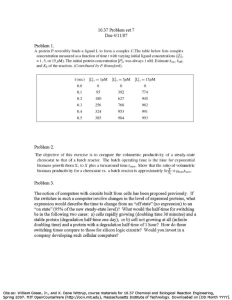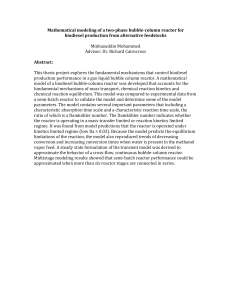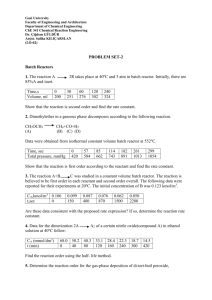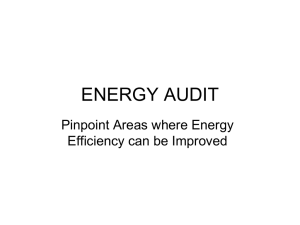Memo 8
advertisement
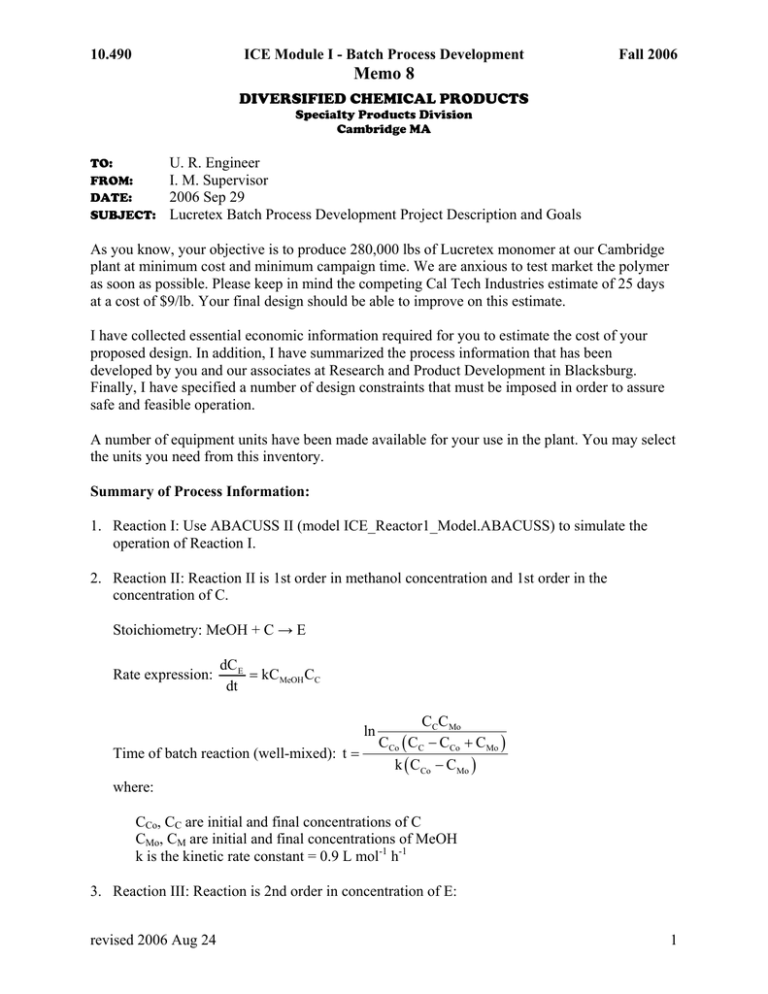
10.490 ICE Module I - Batch Process Development Fall 2006 Memo 8 DIVERSIFIED CHEMICAL PRODUCTS Specialty Products Division Cambridge MA TO: FROM: DATE: SUBJECT: U. R. Engineer I. M. Supervisor 2006 Sep 29 Lucretex Batch Process Development Project Description and Goals As you know, your objective is to produce 280,000 lbs of Lucretex monomer at our Cambridge plant at minimum cost and minimum campaign time. We are anxious to test market the polymer as soon as possible. Please keep in mind the competing Cal Tech Industries estimate of 25 days at a cost of $9/lb. Your final design should be able to improve on this estimate. I have collected essential economic information required for you to estimate the cost of your proposed design. In addition, I have summarized the process information that has been developed by you and our associates at Research and Product Development in Blacksburg. Finally, I have specified a number of design constraints that must be imposed in order to assure safe and feasible operation. A number of equipment units have been made available for your use in the plant. You may select the units you need from this inventory. Summary of Process Information: 1. Reaction I: Use ABACUSS II (model ICE_Reactor1_Model.ABACUSS) to simulate the operation of Reaction I. 2. Reaction II: Reaction II is 1st order in methanol concentration and 1st order in the concentration of C. Stoichiometry: MeOH + C → E Rate expression: dC E = kCMeOH CC dt ln Time of batch reaction (well-mixed): t = CCCMo CCo ( CC − CCo + CMo ) k ( CCo − CMo ) where: CCo, CC are initial and final concentrations of C CMo, CM are initial and final concentrations of MeOH k is the kinetic rate constant = 0.9 L mol-1 h-1 3. Reaction III: Reaction is 2nd order in concentration of E: revised 2006 Aug 24 1 10.490 ICE Module I - Batch Process Development Fall 2006 Memo 8 Rate expression: dCH2 O dt = 1 dCE = − kCE 2 2 dt Time of batch reaction (well-mixed): Arrhenius Expression: k = k o e − Ea 1 1 − = 2kt C E C Eo RT ko = 9.14215·1011 L mol-1 h-1, Ea = 83,354 J mol-1 4. Distillations: Use ABACUSS II to simulate the batch distillation tasks. Equipment Inventory: Unit type Reactors Volume (gal) Usage cost ($/h) 500 50 500 50 750 70 750 70 1000 88 Unit type # trays Volume (gal) Columns 8 12 8 8 8 750 750 1000 1250 2000 Combination reactor/column Vapor Rate (kmol/h) 15 20 20 15 10 Usage cost ($/h) 90 110 110 125 175 Intermediate Storage is available in any total amount but only in increments of 250 gallons. Storage costs $5 / h (250 gal increment). Other items of equipment may be made available on negotiation with management. Cost of Raw Materials: Material R1 R2 Toluene Pt catalyst MeOH H2O revised 2006 Aug 24 Cost ($/unit) 4.25 /kg 9.2 /kg 1.52 /kg 55 /L slurry 1.34 /kg 0.015 /kg 2 10.490 ICE Module I - Batch Process Development Fall 2006 Memo 8 Cost of Waste Treatment: Wastes Solids (Pt catalyst, I2, A) Aqueous (MeOH, H2O, Toluene, E) Organic Source Bottoms Distillation II Overheads Distillation III Overheads Distillation I Cost ($/kg) 14.2 2.3 Credit Note the that overheads of distillation task I is organic waste, and the waste treatment facility can recover 80% by mass of the toluene, methanol, and R1 in this stream as pure solvent and reagent for recycle. The waste treatment facility will credit your design with 40% of the raw material cost for the mass it can recover. Cost of Utilities ($/batch): 1. Reaction I heatup: N heat N cap ( Tfeed − 25) Vfinal where Nheat [$ kJ-1] = 5.16·10-6 Ncap [kJ L-1 ºC-1] = 4.18 Tfeed [ºC] is the temperature the reactor contents are preheated to Vfinal [L] is the volume of the reaction mass at the end of the reaction step 2. Reaction I condenser cooling: N coolQc,max t rxn where Ncool [$ kJ-1] = 8.1·10-7 Qc,max [kJ h-1] is the maximum condenser duty required during reaction trxn [h] is the duration of the reaction step 3. Reaction I cooldown: Ncool N cap ( Tfinal − 65) Vfinal where Tfinal [ºC] is the temperature of the reactor contents and the end of reaction 4. Column boilup/condensing: revised 2006 Aug 24 3 10.490 ICE Module I - Batch Process Development Fall 2006 Memo 8 N cond vt dist N boil vt dist where Ncond [$ kmol-1] = 0.0382 Nboil [$ kmol-1] = 0.135 v [kmol h-1] is the vapor rate in the column tdist [h] is the time over which the utility is used 5. Vacuum: N vac ln 760 ( t vac + t avail ) P where Nvac [$ h-1] = 152 P [mmHg] is the absolute pressure in the column during the vacuum step tvac [h] is the time period over which vacuum is applied tavail [h] = 0.3 Assumptions and Process Constraints: 1. Reaction I: (a) Reaction solvation. The ratio of the total mass of R2 fed to the reactor over the entire cycle to the volume of toluene initially charged to the reactor at the preheat temperature should not exceed 0.83 kg L-1. Note that at least the volume of toluene indicated by this criterion must be added in the initial charge to the reactor. (b) Consumption of key reactant. The ratio of the mass of R2 remaining in the reactor at the end of a cycle to the volume of toluene initially charged to the reactor should not exceed 0.014 kg L-1. (c) Reflux cooling duty. Each reactor is constrained by the maximum cooling duty of the overhead condenser used to condense and reflux solvent and reagent that is boiled off during the exothermic reaction. The condensers are sized in proportion to the reactor vessels; thus the maximum cooling duty may be expressed as 150 kJ h-1 per litre of reactor volume. If this constraint is exceeded at any time, solvent and reagent will be vented to the flare with undesirable consequences. (d) Initial reaction heat-up takes 0.5 h. (e) Post-reaction cool-down requires 0.5 h. revised 2006 Aug 24 4 10.490 ICE Module I - Batch Process Development Fall 2006 Memo 8 (f) No reaction takes place during heat-up or cool-down. (g) Molar concentration of undiluted catalyst slurry is 5 mol L-1. 2. Reaction II: (a) Reaction temperature is fixed and constant at 68 ºC. (b) Conversion of C must be ≥ 0.98. (c) Assume no volume change (use a conservative estimate: the larger of the reactant volume or the product volume). 3. Reaction III: (a) Feed ratio specification: The molar ratio of water to E in the charge must exceed 30. (b) Reaction temperature is constant and may not exceed 95 ºC (c) Assume no volume change (use conservative estimate). (d) Assume mixture does not boil. 4. Distillations I and II: (a) Lump components C, R2, I1, and R1 into R1. Use the properties of R1. (b) Lump component I2 and catalyst into I2. Use the properties of I2. (c) There is a maximum pot temperature of 140 ºC. Exceeding this temperature allows unwanted byproduct reactions to be catalyzed. These reactions will rapidly degrade product A. (d) An initial operating period of 0.5 h is required at total reflux to bring the column to steady-state before distillate can be removed. At any later time it takes the column 0.25 h to stabilize after any step change in reflux rate (note that this transient is not modeled by the ABACUSS simulation, so that these times must be added to the computed distillation time). (e) The pressure in the column may be reduced at a maximum rate of 0.4 mmHg s-1. The time it takes to apply vacuum is included in the simulation time reported by ABACUSS. (f) The pressure in the column may not be reduced below 15 mmHg. (g) The second cut must be cooled before it can be transferred to reaction III. This cooling period will take 0.5 h. 5. Distillation III: revised 2006 Aug 24 5 10.490 ICE Module I - Batch Process Development Fall 2006 Memo 8 (a) Do not model components that are not present in the charge to the pot, nor components that are present only in trace amounts. This will make the numerical solution much more robust. (b) There is a purity specification on the product (A and D) from this distillation. The product should be at least 99% pure A and D on a mass basis. (c) An initial operating period of 0.5 h is required at total reflux to bring the column to steady-state before distillate can be removed. At any later time it takes the column 0.25 h to stabilize after any step change in reflux rate (note that this transient is not modeled by the ABACUSS simulation, so that these times must be added to the computed distillation time). (d) The pressure in the column may be reduced at a maximum rate of 0.4 mmHg s-1. The time it takes to apply vacuum is included in the simulation time reported by ABACUSS. (e) The pressure in the column may not be reduced below 15 mmHg. (f) Use the Wilson model for the liquid phase fugacity and the ideal gas equation of state for the vapor phase fugacity. (In fact, water and toluene are immisicible, but the Wilson model is incapable of predicting vapor-liquid-liquid equilibria.) Neglect this inaccuracy in your model. All necessary physical property parameters may be found in Memo #7. 6. Additional Constraints and Assumptions: (a) Transferring material between pieces of equipment will take 0.5 h. This should be taken into account when conducting the analysis of the simulation. (b) Any density data that you require should be taken from the property file provided earlier or from standard references. revised 2006 Aug 24 6
